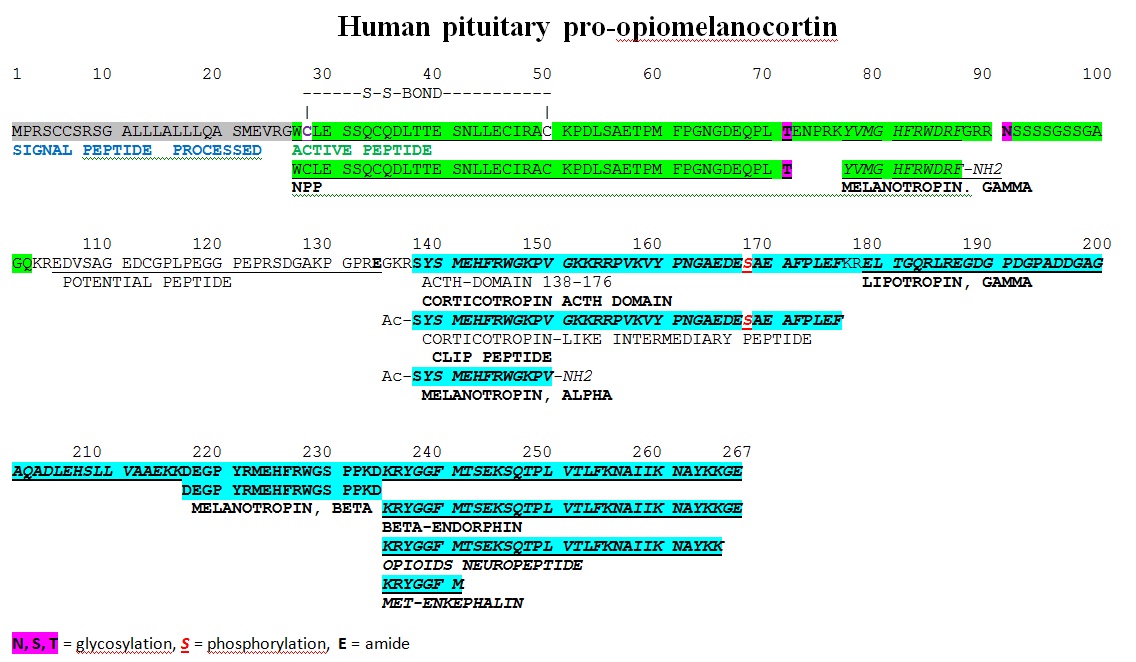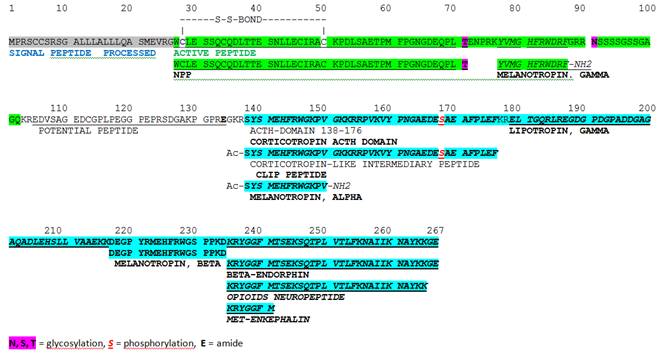Endorphins are opiate or opiate-like peptides present in humans and mammals, as well as in other species. These peptides are the natural ligands of opiate receptors and therefore belong to the “Opioids neuropeptide family”. The term “ligand” used in biochemistry and pharmacology refers to a substance that can form a complex with a biomolecule. This term originates from the Latin “ligandum” which meaning is “binding”. In biochemistry a ligand usually refers to a signal-triggering molecule, such as a small molecule or peptide that binds to a specific site on a target protein. The opioids neuropeptide family corresponds to peptides that have the conserved YGG motif in there sequence that is found in a wide variety of opioid neuropeptides such as enkephalin. The peptides have similar effects as morphine. However, unlike morphines, the activation of these receptors by endorphins does not lead to addiction or dependence. The term “endorphins” was indented to be used for peptides that show opiate-like effects, which includes enkephalins, but it is now used in a narrower sense. However, the term implies a pharmacological activity and it consists of the parts endo- and –orphin which is a shorter version of the words endogenous and morphine, referring to "a morphine-like substance originating from within the body." Endorphins were originally isolated from the brain but were later found in many parts of the body. Endorphins are considered to be one of the three major groups of endogenous opioid peptides. Endorphin peptides are produced in the brain, spinal cord, and many other parts of the human and animal body and are released in response to the brain’s neurotransmitters. These peptides are derived from the pro-opiomelanocortin precursor. Known members of this group are alpha-, beta-, and gamma-endorphin. Sometimes opioid peptides are also referred to as endorphins but since there are more opioid peptides that have been identified they now belong to a broader group. Since the first two pentapeptides were isolated from the brain by Hughes et al. (1975) many other opioid peptides have been identified in the brain. The two peptides, methionine-enkephalin (Met-ENK) and leucine-enkephalin (Leu-ENK), are known to have potent opiate agonist activities. Using radioimmunoassay and immunocytochemistry it was possible to demonstrate that these peptides are present in the striatum. The striatum is a part of the brain below the cerebral cortex inside the forebrain which receives input from the cerebral cortex and is the primary input to the basal ganglia system.
Endorphins function as inhibitory neurotransmitters, which are endogenous molecules that transmit signals across a synapse from one neuron to another 'target' neuron. In the nervous system endorphins bind to the same receptors that bind exogenous opiates. These molecules originate from within the organism, tissue, or cell that make up the synapse. In vertebrates the pituitary gland and the hypothalamus produces endorphins during exercise, excitement, pain, spicy food consumption, love, and sexual activity. Similar to opiates endorphin peptides function as pain killers (produce analgesia) and produce feelings of well-being. A variety of these peptides have been isolated that vary in their physical and chemical properties as well as in their physiological action. In other words endorphins are hormonal compounds that are produced by the body in response to pain or extreme physical exertion. Endorphins are similar in structure and have a similar effect as opiate drugs and are responsible for the so-called runner's high. The hormonal release of these essential compounds enables humans to endure childbirth, accidents, and strenuous everyday activities.
It is well known that the body and mind of humans interact extensively with each other allowing humans to stay healthy. Biological reactions to stress at the molecular level involve chemical cascades initiated within the central nervous system and extend to the body’s periphery. The immune, endocrine, and autonomic systems are participating in these chemical events. It appears that chronic neurobehavioral stress promotes various tumor growth and progression. Furthermore, it has been observed that the activation of the sympathetic nervous system can down regulate tumor-suppressive genes, inhibit immune function, and promote tumor growth. Many doctors have noticed that an optimistic attitude or psychological intervention can help cancer patients to survive longer. Apparently this occurs via an increase in β-endorphin causing a neuronal suppression of stress hormone levels. β-endorphin appears to control tumor suppressor genes and innate immune cells to destroy and clear tumor cells by activation of the parasympathetic system. In addition endorphins also trigger a positive feeling in the body, similar to that of morphine. For example, the feeling that follows a run or workout is often described as "euphoric” and this feeling, known as a "runner's high," can be lead to a positive and energizing outlook on life. Endorphins act as analgesics by diminishing the perception of pain as well as acting as sedatives. Regular exercise has been shown to reduce stress, prevent anxiety and feelings of depression, boost self-esteem, and improve sleep. The sequence of β-endorphin is highly conserved in mammals as can be verified using the BLAST search option.
The pro-opiomelanocortin or POMC gene encodes a polypeptide hormone precursor that undergoes extensive, tissue-specific, post-translational processing via cleavage by subtilisin-like enzymes known as prohormone convertases. Pro-opiomelanocortin is a primary translation product produced in the anterior pituitary. This polyprotein is enzymatically cleaved to yield several hormonal peptides. The polypeptide precursor contains eight potential cleavage sites and, depending on tissue type and the available convertases, enzymatic processing may yield as many as ten biologically active peptides. These different peptides can be involved in diverse cellular functions. The encoded protein is synthesized mainly in corticotroph cells of the anterior pituitary. Cells called corticotropes are basophilic cells in the anterior pituitary that produces melanocyte-stimulating hormone, adrenocorticotropic hormone and lipotropin. When these cells use four cleavage sites adrenocorticotrophin, essential for normal steroidogenesis and the maintenance of normal adrenal weight, and lipotropin beta are the major end products. In other tissues, including the hypothalamus, placenta, and epithelium, all cleavage sites may be used. This produces peptides with roles in pain and energy homeostasis, melanocyte stimulation, and immune modulation including several distinct melanotropins, lipotropins, and endorphins that are contained within the adrenocorticotrophin and beta-lipotropin peptides. Furthermore, mutations in this gene have been associated with early onset obesity, adrenal insufficiency, and red hair pigmentation. Furthermore, alternatively spliced transcript variants encoding the same protein have been described. During the recent decade, specific and highly potent small-molecule neuropeptide receptor agonists and antagonists have been developed. These molecules can cross the blood–brain barrier and there clinical assessment for several compounds is currently underway.
The following scheme outlines the processing of the human pro-opiomelanocortin or POMC polypeptide hormone precursor.


References
Anjana Bali, Nirmal Singh and Amteshwar Singh Jaggi; Bottom of Form
Neuropeptides as Therapeutic Targets to Combat Stress-Associated Behavioral and Neuroendocrinological Effects. CNS Neurol Disord Drug Targets. 2014 Mar;13(2):347-68.
Dalayeun JF, Norès JM, Bergal S; Physiology of beta-endorphins. A close-up view and a review of the literature. Biomed Pharmacother. 1993; 47(8):311-20.
Andrew Holmes, Markus Heilig, Nadia M.J. Rupniak, Thomas Steckler and Guy Griebel; Neuropeptide systems as novel therapeutic targets for depression and anxiety disorders. TRENDS in Pharmacological Sciences Vol.24 No.11 November 2003.
Neuropeptides. Methods and Protocols. Edited by Adalberto Merighi Huaman Press, Springer New York Dordrecht Heidelberg London.
Peptides and neurological diseases. ROGRESS IN BRAIN RESEARCH VOLUME 66 EDITED BY P. C. EMSON, M. ROSSOR and M. TOHYAMA. ELSEVIER AMSTERDAM - NEW YORK – OXFORD I986.
Sarkar DK, Zhang C. Beta-endorphin neuron regulates stress response and innate immunity to prevent breast cancer growth and progression. Vitam Horm. 2013;93:263-76. doi: 10.1016/B978-0-12-416673-8.00011-3.